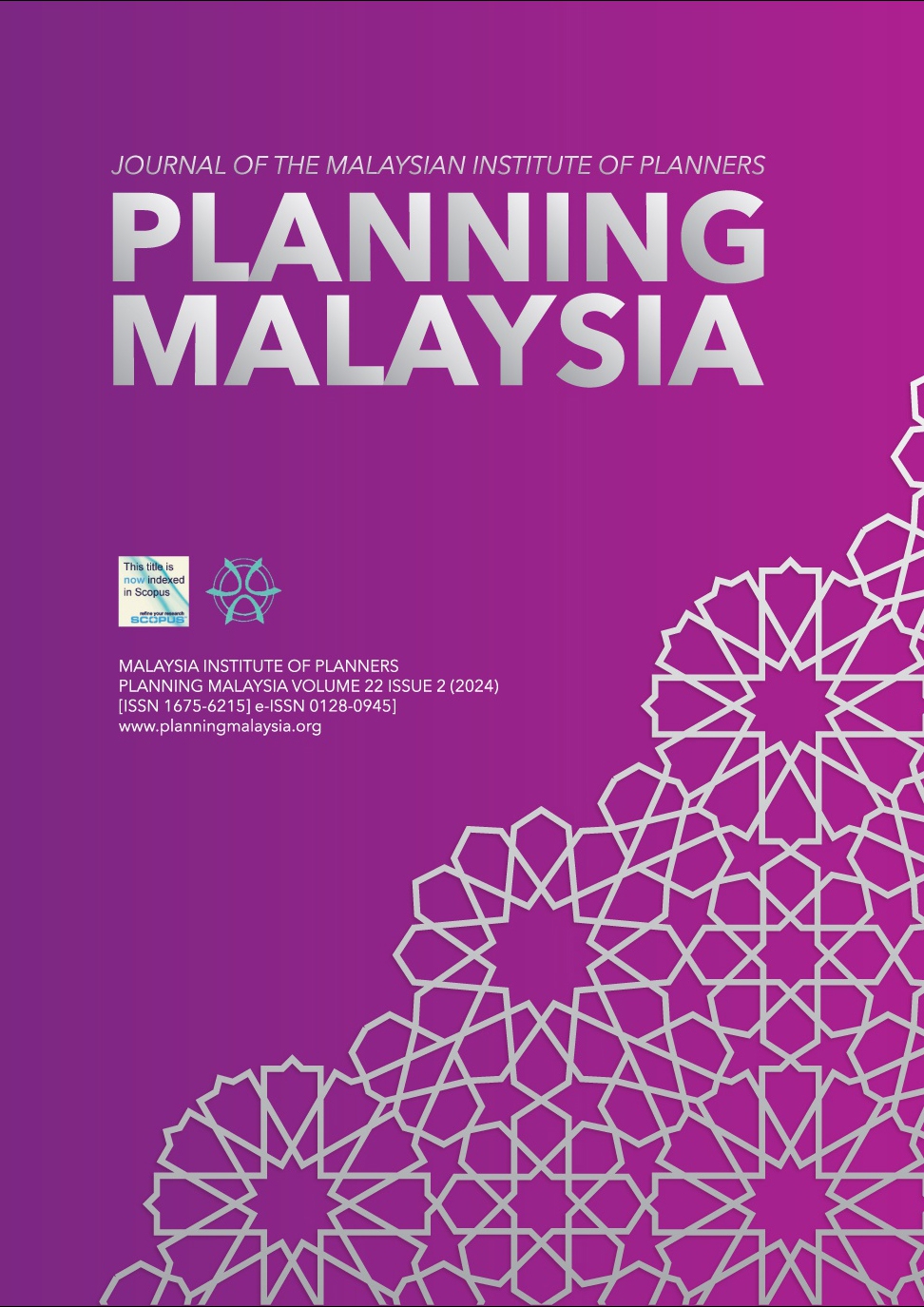CLIMATE RESPONSIVE DESIGN IN HERITAGE STRUCTURE: AN ANALYSIS ON THE DECORATIVE ARCHITECTURAL COMPONENTS DESIGN OF RUMAH LIMAS BUMBUNG PERAK (RLBP)
DOI:
https://doi.org/10.21837/pm.v22i31.1481Keywords:
Climatic Responsive, Decorative Architectural Components, Design Attributes, Heritage Structure, Rumah Limas Bumbung PerakAbstract
The absence of readily available energy in the past such as electricity has contributed to the indigenous formation of a climate-responsive dwelling structure that harnesses the provided energy from nature. The decorative architectural component is one of the heritage values in traditional Malay house that is not only functional but also symbolic and aesthetic towards the house's heritage architectural character. The aim of this research is to explore the climatic responsive function of the decorative architectural components of Rumah Limas Bumbung Perak (RLBP). Qualitative research was used as the research approach via case studies. This encompassed field works of site observation conducted on the decorative architectural components observed from the 9 samples of Rumah Limas Bumbung Perak (RLBP) chosen. The analysis was conducted by analysing the design attributes of the decorative architectural components that lead to the research findings. The findings of the research found that the design attributes of the decorative architectural components of RLBP correspond to multiple climatic functions – as a shading and filtering device, ventilation device, and climate protection device that contributes to the climate responsive design of the components. The output from this research not only strengthened the existing findings but also can contribute to the formation of the planning guideline for future housing planning in Malaysia, particularly on the spatial and sustainable quality of modern house design.
Downloads
References
Ahmad, S., Yetti, A. E., Ali, N. E., Sanusi, M. S., & Samsudin, P. Y. (2022). Adaptation of traditional Malay house design towards housing comfort and satisfaction. Malaysian Journal of Society and Space, 18(3), 216–226. https://doi.org/10.17576/geo-2022-1803-14 DOI: https://doi.org/10.17576/geo-2022-1803-14
Ahmed, W., Asif, M., & Alrashed, F. (2019). Application of building performance simulation to design energy-efficient homes: Case study from Saudi Arabia. Sustainability (Switzerland), 11(21). https://doi.org/10.3390/su11216048 DOI: https://doi.org/10.3390/su11216048
Choo, I. A. H. (2022). The Physical Attributes of Decorative Architectural Components of Rumah Limas Bumbung Perak. UiTM Perak Campus.
Choo, I. A. H., Rashid, M. S. A., & Nazrul Helmy, J. (2020). The Typology of Rumah Limas Bumbung Perak (RLBP). Planning Malaysia, 18(2), 24–36. DOI: https://doi.org/10.21837/pm.v18i12.740
Daud, S., Wan Hanafi, W. N., Ayodele, B. V., Rajadurai, J., Mustapa, S. I., Ahmad, N. N., … Afsarizal, H. A. (2023). Residential Consumers’ Lifestyle Energy Usage and Energy Efficiency in Selected States in Malaysia. Energies, 16(8), 1–18. https://doi.org/10.3390/en16083514 DOI: https://doi.org/10.3390/en16083514
Denan, Z., Majid, N. H. A., & Arifin, N. (2015). Ingenious Malay Wood Carving as Daylight Filtering Devices. Procedia - Social and Behavioral Sciences, 201(February), 182–190. https://doi.org/10.1016/j.sbspro.2015.08.167 DOI: https://doi.org/10.1016/j.sbspro.2015.08.167
Hanafi, Z. (1996). Pembinaan Bangunan Tradisional Melayu. Amber-Solara Publication.
Hanafi, Z. (2007). Reka bentuk Pola Hiasan Dalam Bangunan Tradisional Melayu. Amber-Solara Publication.
Harun, S. N. (2005). Perkembangan Sejarah dan Pengaruh ke Atas Senibina di Malaysia : Sebuah Tinjauan Ringkas. Buletin Perancang, Jabatan Perancang Dan Daerah, 100.
Hussain, M. A., Yunos, M. Y. M., Ismail, N. A., Ariffin, N. F. M., & Ismail, S. (2020). A review of the elements of nature and the malay cultural landscape through Malay literature. Sustainability (Switzerland), 12(6), 1–13. https://doi.org/10.3390/su12062154 DOI: https://doi.org/10.3390/su12062154
Kamarudin, Z., & Said, I. (2011). Configuration of carved components and its layout patterns in malay timber houses. Archnet-IJAR, 5(1), 7–21.
Mohd Nawayai, Siti Salwana Denan, Z., & Abdul Majid, N. H. (2020). Readaptation of Malay Vernacular Architecture. Planning Malaysia, 18(2), 158–169. DOI: https://doi.org/10.21837/pm.v18i12.751
Nasir, A H, & Aziz, M. Z. H. A. (1985). Pengenalan rumah tradisional Melayu Semenanjung Malaysia. Kuala Lumpur: Darulfikir, Kuala Lumpur.
Nasir, A H, & Teh, H. H. W. (1996). The Traditional Malay House. Institut Terjemahan Negara Malaysia.
Nasir, Abdul Halim. (1986). Ukiran Kayu Melayu Tradisi. Selangor Darul Ehsan: Dewan Bahasa dan Pustaka, Kementerian Pelajaran Malaysia.
Nik Hassin, N. S. F., & Misni, A. (2019). Assessing the Thermal Performance of Negeri Sembilan Traditional Malay House towards Sustainable Practice. Environment-Behaviour Proceedings Journal, 4(12), 289. https://doi.org/10.21834/e-bpj.v4i12.1914 DOI: https://doi.org/10.21834/e-bpj.v4i12.1914
Othman, J., & Abdul Majid, N. H. (2017). Assessing Aesthetics Preferences of Malay Wood Carved. Science International Journal (Lahore), 29(2), 133–136.
Rasdi, M. T. M., Ali, K., Ariffin, S. A. I. S., Mohamad, R., & Mursib, G. (2005). The Architectural Heritage of the Malay World: The Traditional Houses. Penerbit Universiti Teknologi Malaysia.
Rashid, M. S. A., Baharuddin, M. N., Alauddin, K., & Choo, I. A. H. (2019). Decorative Elements of Traditional Malay House: Comparative Study of Rumah Limas Bumbung Perak (RLBP) and Rumah Limas Johor (RLJ). IOP Conference Series: Earth and Environmental Science, 385(1), 0–10. https://doi.org/10.1088/1755-1315/385/1/012022 DOI: https://doi.org/10.1088/1755-1315/385/1/012022
Rashid, M. S. A. (2017). Rumah KUTAI: Documentation of Memories (M. Kamis, Ed.). Institut Darul Ridzuan.
Rashid, M. S. A., Choo, I. A. H., Ramele, R. B., Baharuddin, M. N., & Alauddin, K. (2018). Decorative elements of traditional Malay houses: Case study of Rumah Limas Bumbung Perak (RLBP). Journal of Social Sciences Research, 2018(Special Issue 6). https://doi.org/10.32861/jssr.spi6.105.115 DOI: https://doi.org/10.32861/jssr.spi6.105.115
Rashid, M. S. A., Alauddin, K., Baharuddin, M. N., & Choo, I. (2019). Architectural Design Evolution of the Malay Traditional Houses Along Sungai Perak. Borneo Journal of Social Sciences and Humanities, 1(1), 1–10. https://doi.org/10.35370/bjssh.2019.1.1-08 DOI: https://doi.org/10.35370/bjssh.2019.1.1-08
Surat, A. D. M. (2018). Senibina Warisan Melayu : Ilham, Falsafah Dan Dayacipta Dari Sudut Penaskahan Dan Kearifan Watan Bangsa Melayu. Seminar Wacana Manuskrip Melayu Perpustakaan Negara Malaysia, 259.
Wu, P., Song, Y., Wang, J., Wang, X., Zhao, X., & He, Q. (2018). Regional variations of credits obtained by LEED 2009 Certified green buildings-A country level analysis. Sustainability (Switzerland), 10(1). https://doi.org/10.3390/su10010020 DOI: https://doi.org/10.3390/su10010020
Yuan, L. J. (1987). The Malay House: Rediscovering Malaysia’s Indigenous Shelter System. Institut Masyarakat.
Downloads
Published
How to Cite
Issue
Section
License

This work is licensed under a Creative Commons Attribution-NonCommercial-NoDerivatives 3.0 Unported License.
Copyright & Creative Commons Licence
eISSN: 0128-0945 © Year. The Authors. Published for Malaysia Institute of Planners. This is an open-access article under the CC BY-NC-ND license.
The authors hold the copyright without restrictions and also retain publishing rights without restrictions.


